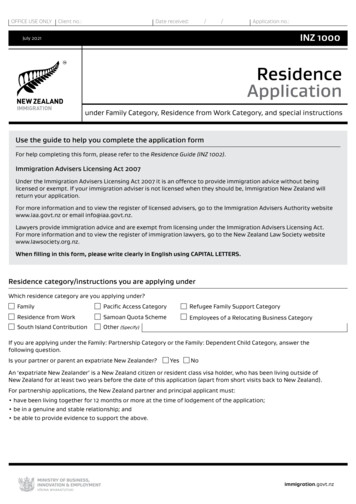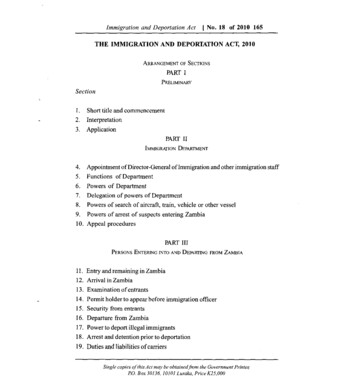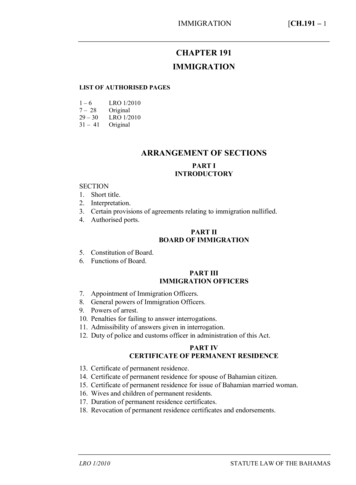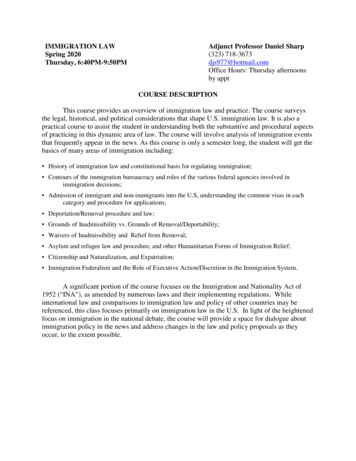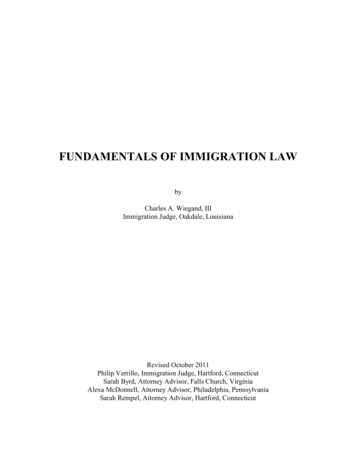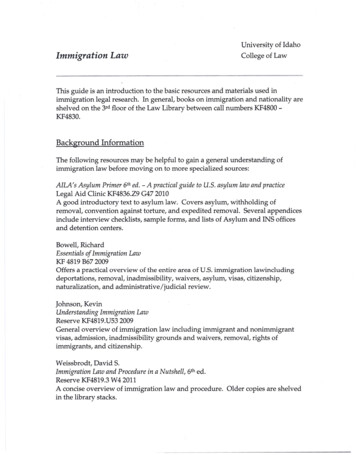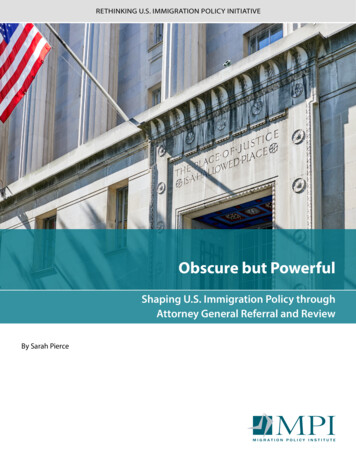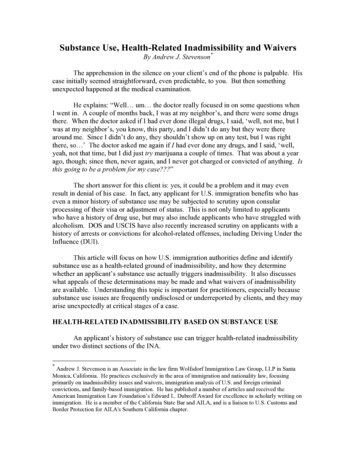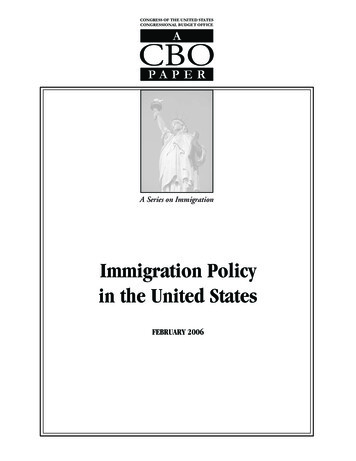
Transcription
4/1/2019Sit-ins Challenge SegregationThe Congress of Racial Equality (CORE) created thesit-in in 1943 as a tactic to desegregate publicbuildings. The sit-in became a common, andpowerful, tactic of the civil rights movement.During a sit-in, protesters sat down in a segregatedpublic place, such as a lunch counter, refusing toleave until they were served.Sit-ins brought strong reactions in some places.People opposed to desegregation would sometimesmock, beat, or pour food on the protesters. Manysit-in participants were arrested and sent to jail.Greensboro, NC Sit-In 1960Four African-American college students inGreensboro, North Carolina, ordered coffee anddoughnuts at a Woolworth’s lunch counter.Restaurant refused to serve them, so studentssat there until it closed.Sparked similar restaurant sit-ins, along with“read-ins” at libraries, “wade-ins” at beaches,etc.A New Voice for StudentsA new civil rights group run by youngactivists, the Student NonviolentCoordinating Committee (SNCC)[pronouncedSnick], began in 1960 at a meeting inRaleigh, North Carolina.SNCC soon became an independent civilrights organization. Its members soughtimmediate change, as opposed to thegradual change advocated by most olderorganizations.1
4/1/2019The Freedom RidesThe Purpose of the FreedomRidesThe 1960 Supreme Courtcase Boynton v. Virginiaexpanded the earlier ban onbus segregation to includebus stations andrestaurants that servedinterstate travelers.In 1961, CORE and SNCCorganized the FreedomRides to test southerncompliance with this ruling.Violence Greets the RidersAlthough the freedom ridersexpected confrontation, theviolence which greeted abus in Anniston, Alabama,was more than they hadanticipated.A heavily armed white mobdisabled the bus and thenset it on fire. As ridersescaped from the bus, theywere beaten by the mob.The Freedom RidesThe Freedom Ridescivil rightsMay 24-25, 1961: National Guard troops protect a Trailways bus near the Mississippistate line as it travels from Montgomery to Jackson on Highway 80 near Cuba. Thetroops were called out after prolonged violence in Montgomery.2
4/1/2019Greyhound bus burning after being set afire by the KKK during theFreedom RidesReaction to the Freedom RidesAmericans were horrified by the violence which hadgreeted the bus in Anniston.Despite the potential danger involved, FreedomRides continued during the summer. Many riderswere arrested.Attorney General Robert Kennedy had originallybeen opposed to lending federal support to theFreedom Rides. However, he later sent federalmarshals to protect the riders.Kennedy also pressured the Interstate CommerceCommission to prohibit segregation in all interstatetransportation. The Justice Department began to suecommunities that did not comply.Questions Why was Dr. Martin Luther King, Jr.so important? Who were the Little Rock Nine? What is the philosophy of CivilDisobedience? What were the Freedom Rides?3
4/1/2019Integration at “Ole Miss”In 1961, James Meredith, a Black student at JacksonState College, applied for admission to the all-whiteUniversity of Mississippi, known as “Ole Miss.”Medgar Evers, a WWII veteran & civil rights activist,worked hard to get Air Force veteran Meredith into“Ole Miss.”When Meredith was rejected, he sought help from theNAACP. The NAACP argued that Meredith’sapplication had been rejected on racial grounds. Whenthe case reached the Supreme Court, Meredith’s claimwas upheld.September 30, 1962 – riot sparked by rumors ofMeredith’s campus arrival – 2 killed and 160 injuredIntegration at “Ole Miss”Meredith continued to face problems as he enrolled at OleMiss. Mississippi Governor Ross Barnett personally blockedMeredith’s way to the admissions office, and violence eruptedon campus.The situation became a standoff between the governor andthe Justice Department. President Kennedy sent federalmarshals to escort Meredith around campus.Meredith enrolled, graduating in 1963June, 1963 – Medgar Evers assassinated by a member of theKKKHis assassin, Byron De La Beckwith, was tried and found notguilty by an all-white jury.In 1994, he was retried and found guilty, sent to prison anddied in 2001.CIVIL RIGHTS in the 1960sJames MeredithMedgar EversSept. 30-Oct. 1, 1962:Mississippi NationalGuardsmen detain astudent protester on theUniversity of Mississippicampus after JamesMeredith tried to enroll.Birmingham News, First Published Feb20064
4/1/2019Clash in BirminghamMarches in BirminghamIn April 1963, Martin LutherKing joined the ReverendFred Shuttlesworth in a civilrights campaign inBirmingham, Alabama.City officials ordered civilrights protesters to end themarch that was part of thiscampaign. When they didnot, King and others werearrested.While in Birmingham Jail,King wrote a famous letterdefending his tactics and histiming.Letter From a Birmingham JailKing wrote the letter after being arrestedat a peaceful protest in Birmingham,AlabamaThe letter was in response to a letter sent tohim by eight white Alabama Clergymen called“A Call For Unity.”The men recognized that injustices wereoccurring in Birmingham but believed that thebattles for freedom should be fought in thecourtroom and not in the streets.In the letter, “Letter From BirminghamJail,” King justified civil disobedience bysaying that without forceful action, truecivil rights would never be achieved.Direct action is justified in the face ofunjust laws.Letters From a Birmingham Jail (cont.)In the letter, King justifies civildisobedience in the town ofBirmingham.“I cannot sit idly in Atlantaand not be concernedabout what happens inBirmingham. Injusticeanywhere is a threat tojustice everywhere.”There can be no gain saying the fact that racial injusticeengulfs this community.Birmingham is probably the most thoroughly segregated city inthe United States. Its ugly record of brutality is widely known.Negroes have experienced grossly unjust treatment in thecourts.”5
4/1/2019Letters From a Birmingham Jail (cont.)“Oppressed people cannotremain oppressed forever.The yearning for freedomeventually manifests itself.”“We know through painful experience that freedom is nevervoluntarily given by the oppressor, it must be demanded bythe oppressed.”“Wait has almost always meant ‘never.”May 3-9, 1963:Protesters faceoff againstBirminghampolice andfirefighters inKelly Ingram parkduringdemonstrations inBirmingham. Theprotests wouldgradually build asthe day went on,often culminatingin conflictbetween the twosides.Birmingham News, FirstPublished Feb 2006Copyright, The Birmingham News, 2006.Children’s Crusade - May 3-9, 1963 Civil rights leaders disagreed onwhether to use students as part of the movement, but public perceptionchanged after photographs showed the children being arrested, sprayed byfire hoses and dodging police dogs. Birmingham News, First PublishedFebThe2006Copyright,Birmingham News, 2006.6
4/1/2019I Have A Dream SpeechIn a powerful speech on August 28,1963, Martin Luther King Jr. statedeloquently that he desired a worldwere Black’s and whites to coexistequally.King’s speech was a rhetoricexample oh the Black Baptist sermonstyle.The speech used The Bible, TheDeclaration of Independence, TheUnited States Constitution and TheEmancipation Proclamation assources. He also used an incrediblenumber of symbols in his poeticaddress.I Have A Dream Speech (cont.)The powerful words of Martin Luther King Jr. “I have a dream that one day this nation will rise upand live out the true meaning of its creed: - 'We holdthese truths to be self-evident, that all men arecreated equal.’” “I have a dream that one day even the state ofMississippi, a state sweltering with the heat ofinjustice, sweltering with the heat of oppression, willbe transformed into an oasis of freedom and justice.” “I have a dream that my four little children will oneday live in a nation where they will not be judged bythe color of their skin but by the content of theircharacter.” “Let Freedom Ring black men and white men, Jewsand Gentiles, Protestants and Catholics - will be ableto join hands and sing in the words of the old Negrospiritual: "Free at last! Free at last! Thank GodAlmighty, we are free at last!"I Have a Dream SpeechBirmingham Church BombingSeptember 15, 1963Sixteenth Street Baptist Church in Birmingham,AlabamaFour young girls killed when bomb explodedAddie Mae Collins (14)Cynthia Wesley (14)Carole Robertson (14)Denise McNair (11)7
4/1/2019Fighting for the VoteFreedom SummerIn 1964, leaders of themajor civil rights groupsorganized a voterregistration drive inMississippi.About 1,000 AfricanAmerican and whitevolunteers participated inwhat came to be calledFreedom Summer.Violence plagued FreedomSummer as volunteers werebeaten, shot at, arrested,and murdered. AfricanAmerican churches andhomes were burned andfirebombed.Murder in Mississippi - 1964Civil rights workers James Chaney, Andrew Goodman, andMichael Schwerner went missing during a trip to investigatethe burning of a church – June 21, 1964Arrested on speeding charges and held incommunicado atNeshoba County JailDeputy Price, a KKK member, alerted his fellow Klansmen tothe situationPrice ordered the three young men to leave town, followedtheir car, then pulled them over againKlansmen arrived and killed the three young men, buriedthem, and set fire to their carLBJ forced J. Edgar Hoover (FBI) to investigateSix-week search for bodies caught national attentionState of Mississippi would not prosecute, so 18 mencharged in federal court (charged with violating victims’ civilrights by murdering them)Civil RightsWorkersAndrew GoodmanJames ChaneyMichael SchwernerDefendantsCecil PriceLawrence RaineyWayne RobertsEdgar Ray KillenSam BowersFBI INVESTIGATORSJoseph SullivanJohn Proctor8
4/1/2019The 24th Amendment - 1964The 24th Amendmentbanned all poll taxes fromFederal elections.The law was ratified onJanuary 23, 1964.It wasn’t until 1966 that theSupreme Court alsobanned poll taxes in stateelections.The Civil Rights Act of 1964After Kennedy was assassinated, PresidentJohnson worked to build support for Kennedy’s civilrights bill.Southern senators tried using a filibuster to block itspassage – 80 days of long speechesJuly, 1964 – became lawEstablished the Equal Employment OpportunityCommission (EEOC)Outlawed segregation in public accommodationsRequired schools to desegregateProvisions of the Civil Rights ActSome Provisions of the Civil Rights Actof 1964Title I — Banned the use of differentvoter registration standards for blacksand whitesTitle II — Prohibited discrimination inpublic accommodations such asrestaurants, hotels, and theatersTitle VI — Allowed the withholding offederal funds from programs thatpractice discriminationTitle VII — Banned discrimination onthe basis of race, sex, religion, ornational origin by employers and unionsand created the Equal EmploymentOpportunity Commission (EEOC)9
4/1/2019Questions What happened at “Ole Miss?” Why was the Letter from theBirmingham Jail important? What is meant by MississippiBurning? Why was the 24th Amendment andthe Civil Rights Act so important?The Selma MarchesSCLC led marches from Selma toMontgomery, Alabama, for voting rightslegislation – about 600 peopleEdmund Pettus Bridge, between Selma andMontgomery became battleground“Bloody Sunday” – March 7, 1965Alabama state troopers and others violentlystopped marchersProtesters vowed to try againMarch 7, 1965, Selma: Using batons and tear gas, Alabama state troopers break up themarch from Selma to Montgomery at the Edmund Pettus Bridge. The clash became knownas "Bloody Sunday."10
4/1/2019Bloody Sunday – March 7, 1965The Selma MarchesAfter the 1st march failed, Martin Luther King gotinvolved.A failed 2nd march did nothing and then came thefinal march of March 21, 1965.President Johnson sent military assistance toprotect the marchers.When the march resumed, more people joined it,making a total of about 25,000 marchers.March 25, 1965: Mississippi Highway Patrolmen watch marchersarrive in Montgomery from Selma.11
4/1/2019The Voting Rights Act of 1965President Johnson responds by pushing a Federal VotingRights Law on national televisionPassed August 6, 1965Voting Rights Act of 1965Outlawed literacy testsFederal government to oversee elections and voterregistrationExtended to Hispanics in 1975Numbers of African Americans registered to vote andelected to office multipliedcivil rightscivil rights12
4/1/2019Race RiotsWatts, Los Angeles, California – August,1965Long-term causes – poverty,discrimination, and police brutalityImmediate cause – African Americanpulled over – his brother wanted to drivecar home but police officer calledimpound lot – brother and motherarrested during argument – crowdgatheredSeveral days of arson and lootingNational Guard called in to restore order35 dead and over 1,000 woundedRace Riot in Watts, 1965Race RiotsNewark, New Jersey – July,1967Long-term causes – Italian-Americans dominated localpolitics despite a large black population – blacks alsosuffered from poverty, poor housing, discrimination, andpolice brutalityImmediate cause – incapacitated African American seenbeing taken to police station and rumors spread that he’dbeen killed while in police custody26 dead and hundreds woundedDetroit, Michigan – July, 1967Long-term causes – police brutality, poverty, and poorhousingImmediate cause – police raid on a blind pig (speakeasy) 50 million in property damage43 deaths and hundreds of injuriesRace Riots 1965-196813
4/1/2019Malcolm XHonors student who ended up in jailConverted to Nation of Islam while in prisonX replaced his “slave name,” LittleInitially advocated separation of races1964 – broke away from Nation of Islam, formed own group,and went on hajj (pilgrimage to Mecca)Trip to Mecca, where he saw all races praying together,convinced him that Islam transcended race1965 – assassinated by members of the Nation of IslamMalcolm XBlack Power“March Against Fear” voter registration drive inMississippiJames Meredith shot and woundedStokely Carmichael and others arrested inGreenwood, MississippiCarmichael coined term “black power” in aspeech after his release – he later coined theterm “institutional racism”Many whites felt threatenedBlack PowerAfrican-American reaction to white resistance tocivil rights movementVaried political ideologies – some adherentsadvocated black separatism and/or the use ofviolence, while others were nonviolent and wanteddesegregation and equalityOverall movement saw blacks linked in a globalstruggle for rights and self-determinationUse of term “black” instead of “colored” or “Negro”(African-American comes later)Celebrated African heritage by adopting Africanhairstyles, names, etc.e.g., Stokely Carmichael became Kwame Toure,Cassis Clay became Mohamed Ali14
4/1/2019Black PanthersFormed by Bobby Seale and Huey Newton in Oakland,CaliforniaRetaliated against police brutality by organizing armedpatrols of black neighborhoodsSocialist doctrine – “Ten Point” program included callsfor “Land, Bread, Housing, Education, Clothing,Justice and Peace”Started urban poverty programs (e.g., free breakfastsfor kids)J. Edgar Hoover, head of the FBI, called them “thegreatest threat to the internal security of the country”and used numerous unlawful methods to destroy thegroupBlack PanthersThe Black PanthersQuestions What happened in Selma, Alabamain 1965? What was the Voting Rights Act? What is Black Power? Who were the Black Panthers?15
Meredith's way to the admissions office, and violence erupted on campus. The situation became a standoff between the governor and the Justice Department. President Kennedy sent federal marshals to escort Meredith around campus. Meredith enrolled, graduating in 1963 June, 1963 - Medgar Evers assassinated by a member of the KKK
